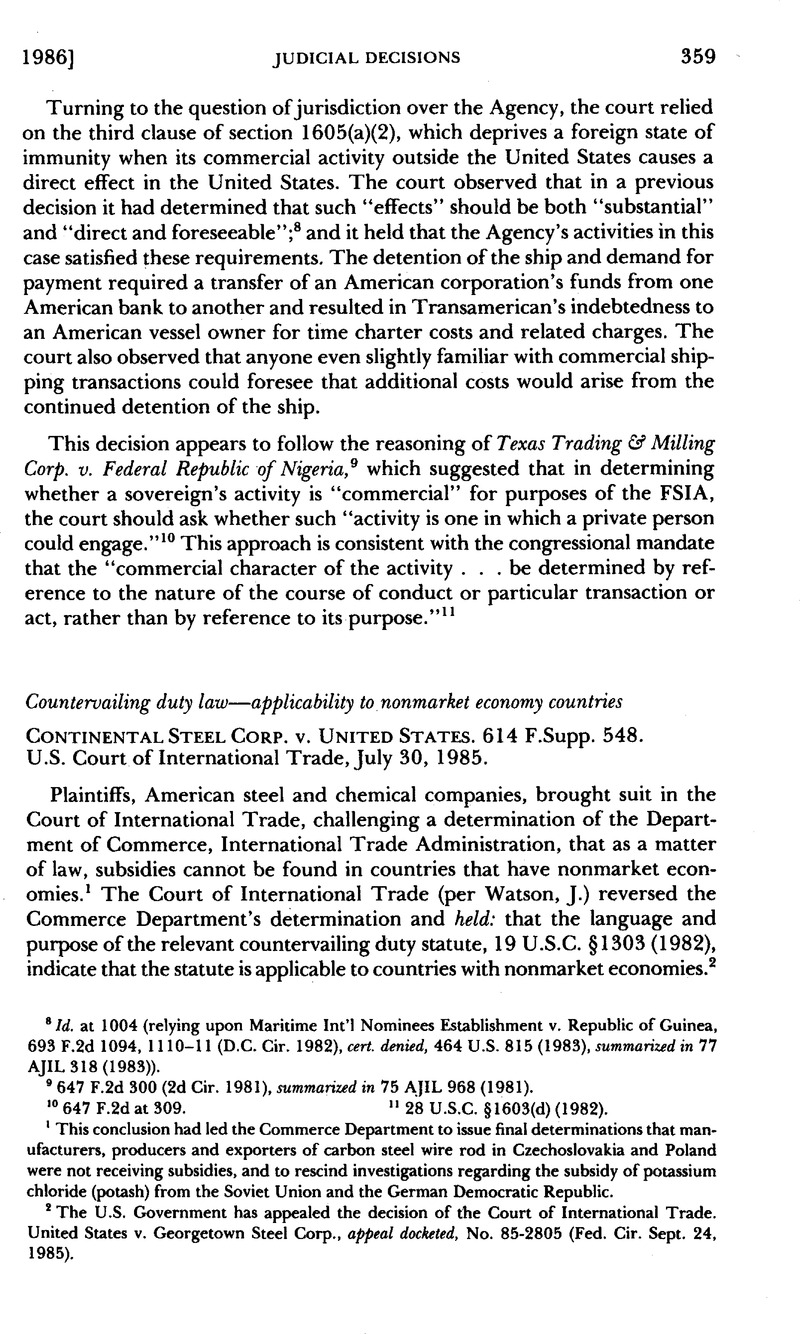Article contents
Continental Steel Corp. v. United States
Published online by Cambridge University Press: 27 February 2017
Abstract

- Type
- Judicial Decisions
- Information
- Copyright
- Copyright © American Society of International Law 1986
References
1 This conclusion had led the Commerce Department to issue final determinations that manufacturers, producers and exporters of carbon steel wire rod in Czechoslovakia and Poland were not receiving subsidies, and to rescind investigations regarding the subsidy of potassium chloride (potash) from the Soviet Union and the German Democratic Republic.
2 The U.S. Government has appealed the decision of the Court of International Trade. United States v. Georgetown Steel Corp., appeal docketed, No. 85-2805 (Fed. Cir. Sept. 24, 1985).
3 614 F.Supp. 548, 552 (emphasis by court).
4 Id.
5 Id. at 550.
6 Id. at 551.
7 Id. at 554.
8 “All that will be needed in these cases is the ability to distinguish between the normal operations of central control and the exceptional or disproportionate or unfair event. . . . Its potential difficulties certainly do not justify the exception to the law sought to be made in this case.” Id. The court also pointed out that when the Commerce Department was faced with a similar problem of a reference point in dealing with nonmarket economies under the antidumping law, the agency solved the difficulty by looking to surrogate countries with market economies. Id. at 555.
9 Id. at 555.
10 Section 406 has proven to be a limited remedy against nonmarket economies. Of the ten investigations conducted to date, only one resulted in relief, which was merely temporary and pursuant to the emergency authority of the President granted in §406(c). See Proclamation No. 4714, 3 C.F.R. 8 (1981), reprinted in Ammonia from the U.S.S.R.-II, at A-85 (Staff Report). The Government abandoned this argument in its brief submitted on appeal. See Brief for Appellant, United States v. Georgetown Steel Corp., No. 85-2805 (Fed. Cir. filed Nov. 25, 1985).
11 Agreement on Interpretation and Application of Articles VI, XVI and XXIII of the General Agreement on Tariffs and Trade, Apr. 12, 1979, 31 UST 513, TIAS No. 9619.
12 The court found that Congress was aware that nonmarket economy countries had participated in the preparation of the Subsidies Code. See Message from the President of the United States Transmitting the Texts of the Trade Agreements Negotiated in the Tokyo Round of the Multilateral Trade Negotiations, Pursuant to Section 102 of the Trade Act of 1974, H.R. Doc. No. 153, 96th Cong., 1st Sess. 259 (1979). Moreover, two nonmarket economy countries—Hungary and Bulgaria—had signed the Subsidies Code. International Trade Commission, Analysis of Nontariff Agreements, U.S.I.T.C. Inv. No. 332-101, MTN Studies 6, pt. 1,96th Cong., 1st Sess. i–iv (Senate Comm. on Finance Print 1979).
13 614 F.Supp. at 557.
14 In the 1930s, the countervailing duty law was applied against tsarist Russia and Nazi Germany, in circumstances in which central governments exercised a high degree of central control. The court observed, however, that these proceedings did not involve nonmarket economies “as the term is being currently used.” Id. at 555. In 1983 the U.S. textile and apparel industries filed a countervailing duty petition against the People’s Republic of China, and the ITA initiated an investigation. 48 Fed. Reg. 46,600 (Oct. 13, 1983). Subsequently, however, petitioners withdrew their petition and the investigation was terminated. 48 Fed. Reg. 55,492 (Dec. 13, 1983).
- 1
- Cited by




